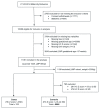Congenital microcephaly unrelated to flavivirus exposure in coastal Kenya
- PMID: 32175480
- PMCID: PMC7059837
- DOI: 10.12688/wellcomeopenres.15568.1
Congenital microcephaly unrelated to flavivirus exposure in coastal Kenya
Abstract
Background: Zika virus (ZIKV) was first discovered in East Africa in 1947. ZIKV has caused microcephaly in the Americas, but it is not known whether ZIKV is a cause of microcephaly in East Africa. Methods: We used surveillance data from 11,061 live births at Kilifi County Hospital in coastal Kenya between January 2012 and October 2016 to identify microcephaly cases and conducted a nested case-control study to determine risk factors for microcephaly. Gestational age at birth was estimated based on antenatal ultrasound scanning ('Scanned cohort') or last menstrual period ('LMP cohort', including births ≥37 weeks' gestation only). Controls were newborns with head circumference Z scores between >-2 and ≤2 SD that were compared to microcephaly cases in relation to ZIKV exposure and other maternal and newborn factors. Results: Of the 11,061 newborns, 214 (1.9%, 95%CI 1.69, 2.21) had microcephaly. Microcephaly prevalence was 1.0% (95%CI 0.64, 1.70, n=1529) and 2.1% (95%CI 1.81, 2.38, n=9532) in the scanned and LMP cohorts, respectively. After excluding babies <2500 g (n=1199) in the LMP cohort the prevalence was 1.1% (95%CI 0.93, 1.39). Microcephaly showed an association with being born small for gestational age (p<0.001) but not with ZIKV neutralising antibodies (p=0.6) or anti-ZIKV NS1 IgM response (p=0.9). No samples had a ZIKV neutralising antibody titre that was at least fourfold higher than the corresponding dengue virus (DENV) titre. No ZIKV or other flavivirus RNA was detected in cord blood from cases or controls. Conclusions: Microcephaly was prevalent in coastal Kenya, but does not appear to be related to ZIKV exposure; the ZIKV response observed in our study population was largely due to cross-reactive responses to DENV or other related flaviviruses. Further research into potential causes and the clinical consequences of microcephaly in this population is urgently needed.
Keywords: Congenital microcephaly; Flavivirus; Zika virus.
Copyright: © 2019 Barsosio HC et al.
Conflict of interest statement
No competing interests were disclosed.
Figures



References
Grants and funding
LinkOut - more resources
Full Text Sources

